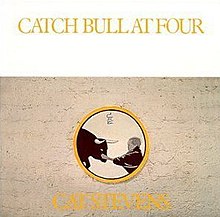music.wikisort.org - Composition
Catch Bull at Four is the sixth studio album by Cat Stevens. The title is taken from one of the Ten Bulls of Zen.[4]
| Catch Bull at Four | ||||
|---|---|---|---|---|
 | ||||
| Studio album by | ||||
| Released | 27 September 1972 | |||
| Recorded | May 1972 | |||
| Studio | The Manor Studio, Oxfordshire; Château d'Hérouville, Hérouville, France; Morgan Studios, London | |||
| Genre | Folk rock, soft rock | |||
| Length | 39:40 | |||
| Label | Island (UK/Europe) A&M (US/Canada) | |||
| Producer | Paul Samwell-Smith | |||
| Cat Stevens chronology | ||||
| ||||
| Review scores | |
|---|---|
| Source | Rating |
| Allmusic | |
| Christgau's Record Guide | C[2] |
| Rolling Stone | (Favorable)[3] |
In the United States the album spent three weeks at number one on the Billboard 200. It also reached number one in Australia and Canada and became Stevens's second consecutive album to reach number two on the UK Albums Chart. The song "Sitting" was released as a single in 1972, reaching 16 on the Billboard Hot 100.
Critical reception
Catch Bull at Four was well received both commercially and critically. Rolling Stone was satisfied with the "gorgeous melody and orchestration", while simultaneously disappointed by the lack of a single track comparable to "Morning Has Broken" from Teaser and the Firecat.[5]
Track listing
All songs written by Cat Stevens except as noted.
Side one
- "Sitting" – 3:14
- "Boy with a Moon & Star on His Head" – 5:57
- "Angelsea" – 4:30
- "Silent Sunlight" – 3:00
- "Can't Keep It In" – 2:59
Side two
- "18th Avenue (Kansas City Nightmare)" – 4:21
- "Freezing Steel" – 3:40
- "O Caritas" (Andreas Toumazis, Jeremy Taylor, Stevens) – 3:41
- "Sweet Scarlet" – 3:49
- "Ruins" – 4:24
Personnel
- Cat Stevens – lead and backing vocals, Grand piano, Fender Rhodes electric piano, Wurlitzer electric piano, RMI Electra piano, Böhm Diamond organ, synthesizer, Spanish guitar, acoustic guitar, electric guitar, electric mandolin, pennywhistle, drums, percussion
- Alun Davies – acoustic guitar, Spanish guitar, backing vocals
- Jeremy Taylor – Spanish guitar, (assisted in translating "O' Caritas" into the Latin language used in the song).[5]
- Andreas Toumazis – bouzouki on "O Caritas"
- Alan James – bass, backing vocals
- Jean Roussel – piano, Hammond organ, Electric piano
- Gerry Conway – drums, percussion, backing vocals
- C.S. Choir – backing vocals on "Freezing Steel" and "O Caritas"
- Linda Lewis – backing vocals on "Angelsea"
- Lauren Cooper – backing vocals on "Angelsea"
- Del Newman – string arrangements
Production
- Paul Samwell-Smith - producer
Chart positions
Weekly charts
|
Year-end charts
|
Certifications
}
| Region | Certification |
|---|---|
| United States (RIAA)[19] | Platinum |
External links
- Album details
- Album information at catstevens.com
- Album review
References
- Ruhlmann, William. Catch Bull at Four at AllMusic
- Christgau, Robert (1981). "Consumer Guide '70s: S". Christgau's Record Guide: Rock Albums of the Seventies. Ticknor & Fields. ISBN 089919026X. Retrieved 13 March 2019 – via robertchristgau.com.
- Rolling Stone review
- zen, 10 bulls by Kakuan
- Connolly, Dave Review and Information regarding Catch Bull At Four
- Kent, David (1993). Australian Chart Book 1970–1992. St Ives, NSW: Australian Chart Book. ISBN 0-646-11917-6.
- "Top RPM Albums: Issue 4218". RPM. Library and Archives Canada. Retrieved 17 June 2022.
- "Dutchcharts.nl – Cat Stevens – Catch Bull at Four" (in Dutch). Hung Medien. Retrieved 17 June 2022.
- Pennanen, Timo (2021). "Cat STEVENS". Sisältää hitin - 2. laitos Levyt ja esittäjät Suomen musiikkilistoilla 1.1.1960–30.6.2021 (PDF). Helsinki: Kustannusosakeyhtiö Otava. p. 246. Retrieved 15 June 2022.
- "InfoDisc : Tous les Albums classés par Artiste > Choisir Un Artiste Dans la Liste : Cat Stevens". infodisc.fr. Archived from the original on 6 May 2013. Retrieved 24 February 2012. Note: user must select 'Cat STEVENS' from drop-down
- "Classifiche". Musica e dischi (in Italian). Retrieved 17 June 2022. Set "Tipo" on "Album". Then, in the "Titolo" field, search "Catch bull at four".
- "Norwegiancharts.com – Cat Stevens – Catch Bull at Four". Hung Medien. Retrieved 17 June 2022.
- "The Official Charts Company – Cat Stevens – Catch Bull at Four" (PHP). Official Charts Company. Retrieved 24 February 2012.
- "allmusic ((( Catch Bull at Four > Charts & Awards > Billboard Albums )))". allmusic.com. Retrieved 24 February 2012.
- "Album Search: Cat Stevens – Catch Bull at Four" (ASP) (in German). Media Control. Retrieved 24 February 2012.[dead link]
- "Les Albums (CD) de 1972 par InfoDisc" (in French). infodisc.fr. Archived from the original (PHP) on 9 February 2012. Retrieved 11 February 2012.
- "Top Pop Albums of 1973". billboard.biz. Retrieved 11 February 2012.
- "Top 100 Album-Jahrescharts" (in German). GfK Entertainment Charts. 1973. Archived from the original on 23 May 2021. Retrieved 2 April 2022.
- "American album certifications – Cat Stevens – Catch Bull at Four". Recording Industry Association of America.
На других языках
[de] Catch Bull at Four
Catch Bull at Four ist das sechste Studioalbum des Sängers und Songwriters Cat Stevens und erschien 1972.- [en] Catch Bull at Four
[es] Catch Bull At Four
Catch Bull at Four es el sexto álbum de estudio del músico y compositor británico Cat Stevens (1947–). Fue el disco más exitoso de Stevens en Estados Unidos. El título proviene de uno de los Diez toros del zen.[1]Другой контент может иметь иную лицензию. Перед использованием материалов сайта WikiSort.org внимательно изучите правила лицензирования конкретных элементов наполнения сайта.
WikiSort.org - проект по пересортировке и дополнению контента Википедии